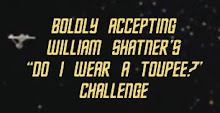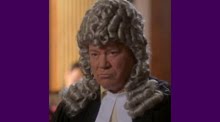
The word sheepish when used in conjunction with the word toupee seems to conjure up all sorts of fusion imagery. However, puns aside, in this post we are sticking to the dictionary definition:
Sheepish: affected by or showing embarrassment caused by consciousness of a fault. (Source: Merriam-Webster Dictionary).

That is exactly how Bill Shatner looked in the 1976 Columbo episode "Fade in to Murder" (we previously examined a particular hair issue here) as the character he played, actor Ward Fowler, alias famous TV detective Lt. Lucerne, described a small concession to vanity to Lt. Columbo. In this case, it was wearing "lifts" (basically thick soled shoes) to increase the character's advertised height. The incident was a rare insight into how Bill Shatner himself might appear when explaining or revealing his toupee use in private:
"Yes, well I would appreciate a certain amount of discretion in that matter, Lieutenant. Public image, you know."
During "Fade in to Murder" Lt. Columbo sneaks into Fowler's dressing room. He tries on part of Lucerne's costume, namely his hat and his shoes, which he discovers are "lifts". This plot point is crucial to the episode as the murderer was described by a witness as being shorter than Fowler (alias Shatner) appears to be.

Bill Shatner had been wearing "lifts" for years in order to increase his height on-screen. Somewhat amazingly, a hitherto non-public aspect of Bill Shatner's private arsenal of on-screen self-improvement tricks (usually focused on hair, height and weight) wasn't merely made public, but was actually thrust right into the very center of the plot of Shats' most important performance in years. And there's more still...
Fowler, ostensibly an actor from Canada (Bill Shatner is Canadian) is also struggling to keep his weight down, chomping on celery and carrot sticks:

We even see the character, sensitive about his image, in a makeup chair:

And, diverting slightly, there's also a very rare sight indeed - a bit of bald scalp showing through the toup:

Add to the above the many differences between Ward Fowler's on-screen persona Lt.Lucerne and the far more flawed actor who portrays him and the clear echoes of Shatner/Kirk or Shatner versus on-screen performer are difficult to ignore.
So what does all of this mean? Importantly, we believe that Bill Shatner's performance in "Fade in to Murder" was a seminal moment in the actor's return to the mainstream after the "Lost Years" period - and one that is often overlooked.

The kind of drama that the 1970s Columbo represented was far more in line with what Bill Shatner had initially dreamed of when he became an actor. But by the 1960s, the old studio system evaporated and the "leading man" model changed significantly (even Star Trek moved away from the exclusively Shatner-centric model after the first thirteen episodes or so). Yet, Columbo represented a rare island where the old style lived on. Terrific guest actors such as Anne Baxter, Jack Cassidy, Robert Culp, Ruth Gordon and Donald Pleasance were given the kind of theatrical, hyper-dramatic roles that an old-school actor would die for. And in 1976, Bill Shatner was welcomed into this company with open arms. It must have represented a moment of salvation for Shatner after all the drek the actor had been making during the mid 1970s.
He and Falk got on very well, and that camaraderie is evident on-screen too. Interestingly, Shatner plays one of those villains whom the audience suspects Columbo actually has affection for. After his confession, Fowler even beckons Columbo to have sympathy for him.
On a side note, Patrick McGoohan, who like Shatner was an exile of the old-school, also found comfort in the Columbo formula, having "escaped" Britain after completing his wonderful 1960s series The Prisoner. Both Shatner and McGoohan would return to the (we think nowhere near as good) revived Columbo series that ran from 1989-2003.

We don't know whether the writers crafted the Ward Fowler role for Shatner or whether he seemed perfect for Fowler/Lucerne once the role was written. Nonetheless, Bill Shatner, sporting a new, still somewhat scruffy "TJ Curly-style" toupee to underline the significance of the occasion (a style, however artificial, that actually matched Bill Shatner's real curly hair - underlining the birth of a new more mature, less-insecure Shatner) rewards viewers with a sensitive, introspective performance. But not only that - he also rewards us with a story that openly deals with previously taboo issues related to Bill Shatner's own height and his weight.
The more theatrical Shatner of the old Star Trek series, for whom such subjects would have been a serious threat to the public image, was finally buried. A new more vulnerable performer was born. Shatner's Captain Kirk in the Trek movies continued and accentuated this transformation. The rigid walls between public image and private insecurities were crumbling, and that is exactly what was demanded of actors in the post leading-man age that Shatner now found himself in. This dose of honesty actually turned Shatner into a far better actor. Sure 60s Shatner could give an outstanding performance, say in Star Trek's "The Enemy Within", but could he have tripped over his chair and said "Klingon bastards killed my son!" (from 1984's Star Trek III: The Search for Spock) with such emotional conviction? Ironically, it took a trip to a television show that celebrated the old formula for Shatner to finally become comfortable with this new more sincere style of acting in which personal insecurities could be mined rather than supressed.
"Fade in to Murder" can be bought as part of this Columbo DVD box-set. A classic episode of the series.
***
And on a final weird and totally unrelated note, we think that for some reason Shatner's occasional goofy expressions in "Fade in to Murder" bear a striking resemblance to...

...his animated Star Trek counterpart...



















I noticed that Shatner's appearance (light-colored eyebrows and dark-colored hair) was the opposite of the animated series Kirk (dark eyebrows and light-colored hair)
ReplyDeleteAre there any hints in the episode that Ward Fowler the character was a toupmaster like the Shat?
I have to disagree though, that this episode was a turning point for Shatner THE ACTOR. All these issues were just contained and sealed in this one episode. Shat went on to wear ever more ridiculous toupees to conceal his baldness (both on-screen and off-screen) when almost no men in their fifties and sixties have hair that thick (and with no traces of grey). BillShat also wanted the issue of age dropped in the second Star Trek film, but of course he didn't get his way on that one. The phony mountain climbing sequences in Star Trek V had to be an absolute low point for him (a reductio ad absurdum).
Yah I agree with RM -- I don't think this episode was a turning point. Really I don't think shatner stopped seeing himself as a real heroic leading man type actor until after the star trek movies ended - maybe around the time he did 3rd rock from the sun or free enterprise. Plus that was when he had the transplant and became comfortable with having thinner hair out in public.
ReplyDeleteI'm also not so sure about your comment about the Shatner in enemy within. It's funny because most of the roles that Shatner played before Star Trek were not traditional leading man type roles -- they were usually weaker men with pretty severe flaws; Shatner's characters were usually quite vulnerable and dependent on their wives or other characters in the episodes to change him (ie., Nick of Time, Outer Limits, Man from UNCLE) - they often had some kind of mental illness, or were often quite effeminate. Shatner could play people who were very pathetic and who had serious problems well, and he never played the traditional leading man type role.
For example, in Brothers Karamazov & the Incubus, he played saintly, pure, innocent type figures. The closest he came, I think, to a leading man was Intruder, but even there the character was very pathetic, couldn't hold his own in a fight, etc.
I think it was only after Alexander the Great and Star Trek started that Shatner really started to see himself as a classic leading man, and I think he became more hyper-masculine as TOS progressed -- Kirk in the first season was more vulnerable and had more depth than he did in the 2nd and third. Even in the Enemy Within, he needs his "lamb" side to survive, and Shatner wasn't afraid to show that. So I think that Shatner in the 1st season of Star Trek would have been able to show Kirk's and his own insecurities with conviction.
Also, I think that in a way, Denny Crane was a return to the types of obviously flawed, insecure, vulnerable characters that Shatner played early on in his career - the difference is that in Crane's case, it's combined with that masculine bravado that Shatner started to develop during Star Trek.
ReplyDeleteSorry for the multiple posts -- I had one last though -- I think another difference btwn the characters shatner played early on and post-Kirk is that the early characters, though flawed, were never insecure about their looks... But I guess that's obviously because Shat was so great looking at that time...
ReplyDeleteOne quasi-leading man role he played during that time in a feature film was in The Explosive Generation.
ReplyDeleteI imagine a lot of the roles that went to Paul Newman during that time might have gone to Shat if Newman hadn't been there. Films like The Hustler, Hud, Somebody Up There Likes Me, Cat on a Hot Tin Roof would have been perfect for Shat if Newman wasn't available.
Shatner did not fade away in the early seventies, even with the ratties movies and rattier toupees. Even here in distant Brazil his second rate movies were broadcasted on television. I was a big Columbo fan I was delighted to watch Bill on it. I was a kid and did not know about toupees, rugs and stuff. And Walter Koenig was there too! Only when I saw Star Trek - The Movie that I started to wonder about the strange hair of the former, but now again, Jim Kirk.
ReplyDeleteInterestingly, in the Columbo episode Identity Crisis, the plot hinges on the discovery that the killer, CIA agent Nelson Brenner, wears a toupee. Patrick McGoohan, who didn't require any toupological support in real life, guest starred. One wonders whether Shatner would have accepted the role had he been offered it ...
ReplyDeleteThat is one furry toupee that shatner wore on Columbo. Just watched the episode tonight on MeTV
ReplyDeleteGood ol' furry head Kirk
I just watched this episode on Freevee...Shatner's hair brought me here!!
ReplyDelete